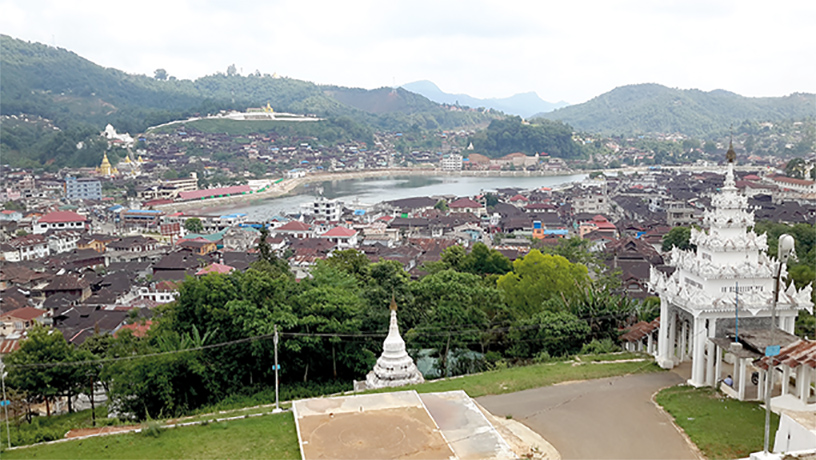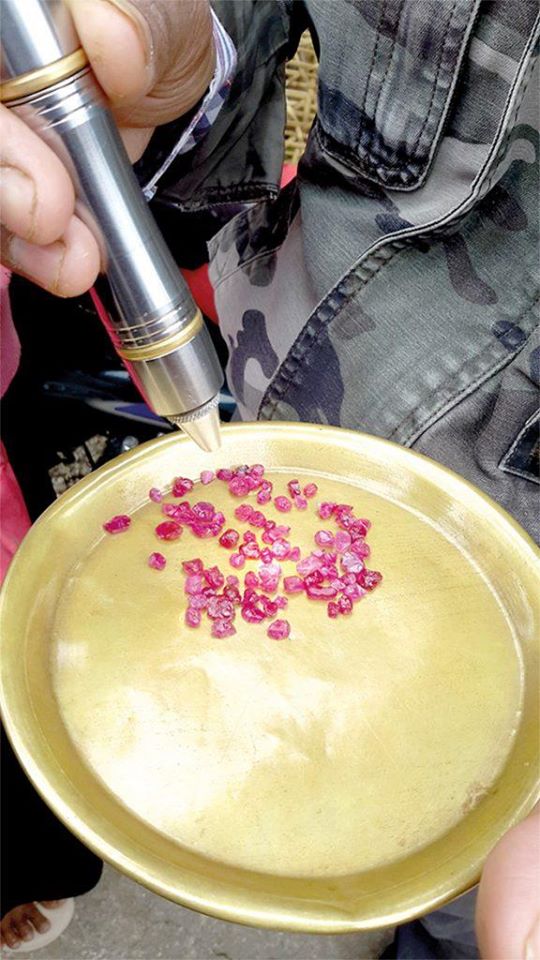By Maung Tha (Archaeology)
International gems markets recognize that pieces of ruby extracted from Myanmar are the best quality and the most significant around the world.
Some volumes of ruby can be excavated in India, Pakistan, Afghanistan and Sri Lanka as well as Myanmar, Thailand and Cambodia in Southeast Asian region.
Mogok and Kyatpyin are inclusive of Mogok Ruby Land. Mogok region mainly produces ruby, sapphire, olivine and quartz from gneiss and crystal lime stones. The area of producing Mogok ruby covers 1,916 square miles of land in Mogok, Momeik, Tagaung and Thabeikkyin.
Gemmology
The gemmology focusing on studying precious gems comprises branches of subject to study igneous rocks, sedimentary rocks and metamorphic rocks.
The stones with three characteristics of beauty, existence and rareness are identified as gems. Starting from about 8th century BC, evaluation of gems such as ruby, diamond and sapphire depended on clearness, colours in harmony, faultless, utility and large size.
Currently, U Maung Thin, a sapphire entrepreneur in Mogok, explained that value of a piece of gem can be assessed through five Cs—country, clearness, carat, cutting and colour. The piece of gems with five aforesaid points will get good prices.
Mineral ruby
Ruby is an oxide mineral with 9 Mohs scale of hardness. Mohs scale of hardness for diamond is 10, and jade, 7. Density of ruby is 4 and diamond 3.5. Ruby and sapphire are same in ingredients. Ruby is red and sapphire, blue.
In Mogok, ruby is extracted in conventional ways. As industrial sector develops, extraction of ruby is undertaken by heavy machinery. As ruby exists in the soil mixed with stones, soil from the mines is panned in the water for extraction of ruby.
In the past, ruby was extracted from soil through four kinds of wells namely large lakes, hillside holes, narrow holes and four-wall holes. In fact, miners from various types of gem mines face dangers such as landslides and suffocation due to lack of oxygen in deep holes for their lives in work process on a daily basis.
Currently, soil is dredged from the wells with the use of heavy machinery to pan it in the water so as to search pieces of ruby. As white stones containing sulpha can bear pieces of ruby, many miners in Mogok crush the stones by small hammer to search pieces of ruby.
In mining the ruby wells, owner of the well, businessperson and well master worked in concert to enjoy profit-sharing process. At present, businesspersons excavate the mines in the allotted plots within the set period with the use of heavy machinery by paying taxes to the State.
Grinding pieces of precious stones
As the excavated pieces of ruby are uncut one, these pieces are grinded for having beautiful positions and lightings. Uncut ruby pieces are grinded by hand. As such, techniques of grinding pieces of ruby are of great importance in the jewellery arena.
Bad skills in grinding the pieces of stone can degrade the value of precious stones. Gem industries in Mogok are being operated with three major work processes—mining, grinding and trading.
The uncut pieces of ruby must be cleaned in water and then dried. The uncut piece of ruby must be stuck with heated lime-wax and softly pushed on the bronze plaque by hand in order to create necessary shapes. The bronze plaque called Seinhmat is in rectangular shaped iron block. The piece of ruby must be interlarded by clamp to grind it in a patient manner. Stone grinder master decides how to create shapes of an uncut stone.
The shaped stone piece is polished at the polishing machine. In so doing, the piece of stone had to be interlarded by buffalo clamp in the past. Now, buffalo clamps are substituted with metal clamps. Merchants trade grinded, shaped and polished precious stones.
Gems trading mall
Not only pieces of ruby but sapphire pieces extracted from Mogok are traded at the mall. The mall is centre of trading pieces of uncut gems and grinded pieces. The mall is bustle and bustle with gem merchants, most of whom are Shan ethnics and resident Gurkhas.
Ward gem malls are located near gem mines. Those from the gems land trade pieces of gems from the morning to noon on a daily basis. Thaphanpin Ward gem mall is crowded with young females and males. They are ready to show pieces of gems on trays with the use of a special torch light each. Anyone set the prices of precious stones but they trade these pieces at deserved prices as they decide. That is why some of them face loss in trading.
In the afternoon, those merchants move to the gems mall in urban area of Mogok. As such, the gems mall is always thronged with traders.
In trading ruby and sapphire pieces on the ruby land, sometimes imitative gem pieces were found, said a gem merchant. As technologies are having advancement in all sectors, skilled persons can make imitative precious stones like genuine ones. Hence, gem merchants operate their businesses based on their own experiences.
Mogok ruby land
Mogok which produces the best quality of ruby pieces across the world is 128 miles from Mandalay. Travellers have easy access to Mogok along Mandalay-Madaya-Kyatpyin-Mogok road and Mandalay-PyinOoLwin-Mogok road. The road from Madaya to Mogok passes hilly parts and carved ones while the route from PyinOoLwin to Mogok is smooth.
Mogok is 30 miles long from the east to the west and 14.12 miles long from the south to the north. The town is located 3,858 feet higher than the sea level. A celebration to mark the 800th founding anniversary of Mogok took place around Myole Lake.
Mogok is surrounded by 6,733 feet high Kyayni Hill in the east, 5,345 feet high Pintku Hill in the west, 5,606 feet high Htinshu Hill in the north and 7,544 feet high Taungme Hill in the south. So, Mogok is in a shape of pan among hills.
Soil of Mogok is home to ruby, sapphire, red stone, alexandrite, topaz, rubellite, felsper, olivine, green jasper and tourmaline.
Mogok was founded in 579 Myanmar era. Its title derived from Meinkut—Mein means town and Kut, curving. So, Mogok means a town established in curved valley.
The majority of local people are engaging in mining and agriculture as well as livestock breeding on a commercial scale. Mogok mainly produces precious stones including ruby and sapphire and tea.
There are seven eminent pagodas, 218 temples and 46 stupas, 307 monasteries and four nunneries in Mogok Township. Of them, PhaungdawU, Chanthagyi, Maha Muni, Shwegugyi, Daw Nang Kyi Hill, Pintku Hill and Kyaukpyatthad Pagoda are the most significant in Mogok Township. So also, there are 75 Christian religious buildings, three Islamic buildings, 35 Hindu temples and eight Chinese Buddhist temples.
As Mogok due to precious ruby has been famous since the town was established 800 years ago, Mogok ruby has been valued not only by Myanmar but also by the world. Although local people extracted pieces of ruby on a manageable scale for their livelihoods in the past, use of heavy machinery in mining process reduced job opportunities of local miners in the plots.
The National Museum of Natural History in Washington D.C. in the United States of America showcases the largest piece of ruby throughout the world weighing 23.1 carats. The ruby was decorated with platinum on which pieces of diamond are filled. Such a piece of ruby was excavated in Mogok in 1930. Philanthropic businessperson Peter Burke donated the ruby to the museum.
As the ruby land produces quality pieces of precious stones till today, prestige of ruby from Mogok will be long lasting with prestige throughout the world in the future.
Translated by Than Tun Aung
Reference:
Basic Gemmology
(Dr. U Thein)
Gemmological Dictionary
(Kyeethe Nyunt Naing)



